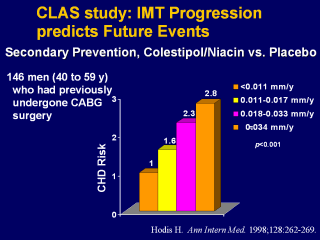| front |1 |2 |3 |4 |5 |6 |7 |8 |9 |10 |11 |12 |13 |14 |15 |16 |17 |18 |19 |20 |21 |22 |23 |24 |25 |26 |27 |28 |29 |30 |31 |review |
 |
Rate of common CIMT progression was directly associated with higher risk for future MI and CHD death. The Cholesterol Lowering Atherosclerosis Study (CLAS) was a clinical arterial imaging trial designed to study the effects of colestipol-niacin therapy on progression of atherosclerosis in the coronary, femoral, and carotid arteries. The objectives of this long-term follow-up (by Hodis, et al) of the CLAS cohort was to determine whether carotid arterial intima media thickness (CIMT) (expressed as a single measurement or as a rate of change) predicts coronary events. A progressive relationship was noted between the rate of change in common carotid IMT and the risk for MI and CHD death. They concluded that noninvasive B-mode ultrasonographic measurement of progression of intima-media thickness in the distal common carotid artery is a useful surrogate endpoint for clinical coronary events. Data such as these establish the utility of serial measurements of CIMT as an “intermediate endpoint," indicative of possible effects on CHD outcomes. Hodis HN, Mack WJ, LaBree L, et al. The role of carotid arterial intima-media thickness in predicting clinical coronary events. Ann Intern Med. 1998;128:262-269. |